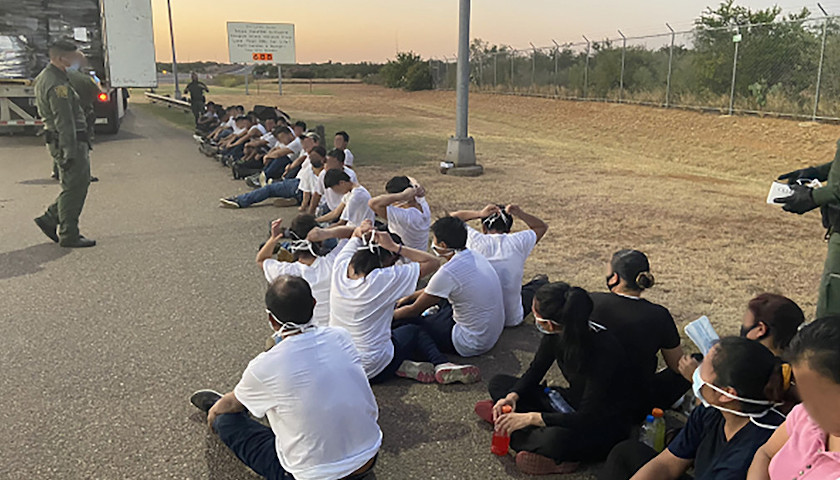Cochise County Supervisor Tom Crosby, who attempted to conduct a hand count of ballots during the 2022 election and delayed the certification of election results, filed a response to Maricopa County and other defendants’ Motion to Dismiss his lawsuit over the election on Sunday. Crosby’s complaint, which asks the court to decertify the election, accused the county of not using voters’ original signatures as required by statute on their voter registrations to compare their ballot affidavit signatures to, something Yavapai Superior Court Judge John Napper ruled in September was illegal.
Napper stated in his decision, denying a motion to dismiss by defendants in Arizona Free Enterprise Club v. Fontes, “Here, the langu[ag]e of the statute is clear and unambiguous. The statute requires the recorder to review the voter’s registration record.” The county used other signatures from voters instead, signatures which didn’t require accompanying photo identification.
The case is assigned to Maricopa County Superior Court Judge Susan Pineda, who was appointed to the bench by Democratic Governor Janet Napolitano.
Crosby’s response, which was drafted by attorney Ryan Heath and made on behalf of a second plaintiff as well, David Mast, said, “This case squarely presents the question of whether State laws that govern consistency in our elections mean what they say — or whether they are meaningless guidelines to be tossed aside based on the whims of those in power.”
The defendants’ motion to dismiss, which was joined by multiple Arizona officials named as defendants including Democratic Governor Katie Hobbs, asserted that comparing voters’ signatures on their ballot affidavits to their signatures on other documents was a small “procedural” violation and insignificant. However, the response pointed out that the law states that this type of error is “non-technical,” and it is a nondiscretionary law.
A.R.S. 16-550(A) says, “Except for early ballots tabulated as prescribed in section 16-579.02, on receipt of the envelope containing the early ballot and the ballot affidavit, the county recorder or other officer in charge of elections shall compare the signatures thereon with the signature of the elector on the elector’s registration record.”
This is also laid out in the state’s Election Procedures Manual (EPM). Violations of the EPM are a class 2 misdemeanor.
The complaint was a Writ of Mandamus, which is a request to order the government to do something it is supposed to do but has failed to do. It laid out why a Writ of Mandamus is appropriate: “[M]andamus relief is available for two reasons. First, Maricopa County deviated from Arizona law and the EPM without any discretion to do so and, second, Plaintiffs had no way of knowing about Maricopa County’s deviation from Arizona law and the EPM until May of 2023 and, thus, A.R.S. §§ 16-672 and 16-673 are inadequate remedies as a matter of law.”
The response cited the decision by Yavapai Superior Court Judge John Napper rejecting a Motion to Dismiss the Arizona Free Enterprise’s lawsuit against Secretary of State Adrian Fontes on the same subject.
“Registering your child to play in a soccer tournament is not the same thing as the child playing in the tournament,” Napper said in his ruling. “Registering to attend law school is not the same thing as attending classes. Registering to vote is not the same thing as voting. Applying the plain and obvious meaning of ‘registration,’ the legislature intended for the recorder to attempt to match the signature on the outside of the envelope to the signature on documents the putative voter used to register.”
The complaint noted that the critical difference between a signature on a voter registration form and another document was that the former was required to provide identification, including proof of U.S. citizenship.
Maricopa County Recorder Stephen Richer claimed that the EPM allows election workers to replace the voters’ signatures on record from the registration forms with their signatures on mail-in ballots. But the EPM, the response noted, actually states that only signatures accompanying in-person ballots may be used to update the voter registration signatures. When people vote in person, they are required to show identification.
The response acknowledged that the EPM permits signature verification workers to examine other signatures for voters, but only in addition to their voter registration signatures, not in place of them.
The defendants claimed the lawsuit was barred by laches, meaning it was filed too late since the plaintiffs already knew the county would compare the signatures to others. The county said its Elections Plan “gave clear notice that the verified historical signatures to be used for comparison could derive from ‘voter registration forms, in-person roster signatures and early voting affidavits from previous elections.’”
However, Crosby said that the plan did not clarify that the county would use the mail-in affidavits, not the in-person voting affidavit signatures. It was also not untimely as an election contest either, Crosby said, because it wasn’t an election contest. “Rather, this novel suit seeks to vindicate Plaintiffs’ rights to free and fair elections secured by the Arizona Constitution,” he said.
Another argument the defendants made was that decertifying the election would disenfranchise many voters. Crosby responded, “This argument is ironic, however, given that Maricopa County’s conduct resulted in hundreds of thousands of illegal votes being counted in the Contested Races — each of which proportionately diluted the strength of all legal votes in Arizona.”
The brief said, “Consequently, County Defendants included hundreds of thousands of illegal votes, affecting the results for the Contested Races.” It cited the standard established in law by the landmark Miller v. Picacho Elementary School case, “When a non-technical statute is violated, and the violation renders the results of any election mathematically ‘uncertain,’ the results from the uncertain election must be set aside.”
The response also cited Reyes v. Cuming, a similar case involving illegal votes where the final court found that even though it would be “impracticable” for the elections department to comply with the signature verification statute fully, instead of just “substantial compliance,” “it does not excuse the complete noncompliance with this nontechnical statute. … Indeed, “[e]lection statutes are mandatory, not ‘advisory,’ or else they would not be law at all.”
Crosby emphasized that it’s not required to show fraud in order to overturn an election.
He said, “In Miller, the Arizona Supreme Court ‘established that an individual challenging an election need only show that absentee ballots counted in violation of a non-technical statute changed the outcome of the election [or rendered it ‘uncertain’]; actual fraud is not a necessary element.’ In other words, the absence of tangible ‘evidence that any ballots were cast by persons other than registered voters is irrelevant.’
Based on how many signatures were verified in Maricopa County, “it is highly plausible that hundreds of thousands of votes were illegally tabulated in Maricopa County,” the brief said.
Democratic Attorney General Kris Mayes, one of the named defendants, is prosecuting Crosby and Cochise County Supervisor Peggy Judd over their attempts to conduct a hand count and delay certification of the 2022 election.
– – –
Rachel Alexander is a reporter at The Arizona Sun Times and The Star News Network. Follow Rachel on Twitter / X. Email tips to [email protected].






Great article. It further exposes the corrupt administration currently in power in Arizona. The problem is, that nothing will happen to the bad guys, and the good guys will suffer. Typical dictatorship.
From the article: “This case squarely presents the question of whether State laws that govern consistency in our elections mean what they say — or whether they are meaningless guidelines to be tossed aside based on the whims of those in power.”
This is EXACTLY what I have been wondering about. What is the point of having written law if it can just be ignored repeatedly, with no consequences? How are judges able to go along with that?